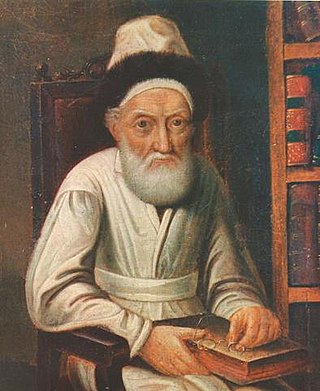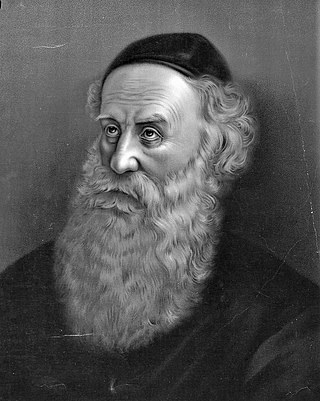Related Research Articles

Kislev or Chislev, also 'Chisleu' in the King James Bible, is the third month of the civil year and the ninth month of the ecclesiastical year on the Hebrew calendar. In the Babylonian calendar its name was Araḫ Kislimu.

Chabad, also known as Lubavitch, Habad and Chabad-Lubavitch, is an Orthodox Jewish Hasidic dynasty. Chabad is one of the world's best-known Hasidic movements, particularly for its outreach activities. It is one of the largest Hasidic groups and Jewish religious organizations in the world. Unlike most Haredi groups, which are self-segregating, Chabad operates mainly in the wider world and caters to secularized Jews.

Menachem Mendel Schneersohn also known as the Tzemach Tzedek was an Orthodox rabbi, leading 19th-century posek, and the third rebbe of the Chabad Lubavitch Hasidic movement.

Shneur Zalman of Liadi was a rabbi and the founder and first Rebbe of Chabad, a branch of Hasidic Judaism, then based in Liadi in the Grand Duchy of Lithuania and later in the Grodno Governorate of the Russian Empire. He wrote many works, and is best known for Shulchan Aruch HaRav, Tanya, and his Siddur Torah Or compiled according to the Nusach Ari.

Sholom Dovber Schneersohn was the fifth Rebbe of the Chabad Lubavitch chasidic movement. He is known as "the Rebbe Rashab". His teachings represent the emergence of an emphasis on outreach that later Chabad Rebbes developed into a major theme.
A nigun or niggun is a form of Jewish religious song or tune sung by groups. It is vocal music, often with repetitive sounds such as "Bim-Bim-Bam", "Lai-Lai-Lai", "Yai-Yai-Yai" or "Ai-Ai-Ai" instead of formal lyrics. Sometimes, Bible verses or quotes from other classical Jewish texts are sung repetitively to form a nigun. Some nigunim are sung as prayers of lament, while others may be joyous or victorious.
Dovber Schneuri was the second Rebbe of the Chabad Lubavitch Chasidic movement. Rabbi Dovber was the first Chabad rebbe to live in the town of Lyubavichi, the town for which this Hasidic dynasty is named. He is also known as the Mitteler Rebbe, being the second of the first three generations of Chabad leaders.

A Tish, also tische is a Shabbat or holiday gathering for Hasidic Jews around their Rabbi or "Rebbe". In Chabad, a tische is called hitveadut (התועדות). It may consist of speeches on Torah subjects, singing of melodies known as niggunim and zemirot ("hymns"), with refreshments being served. Hasidim see it as a moment of great holiness.

The 19 Kislev refers to the 19th day of the Jewish month of Kislev.
David Werdyger was a Polish-American Hasidic hazzan and solo singer. A Holocaust survivor who was incarcerated in several Nazi concentration camps, including the factory run by Oskar Schindler, Werdyger moved to Brooklyn, New York, after World War II and began recording albums featuring the music of the Bobov, Boyan, Skulen, Melitz, Radomsk, and Ger Hasidic dynasties, recording 60 albums in all. He also established the Jewish record label Aderet Records, now managed and owned by his son Mendy Werdyger.

The Library Of Agudas Chassidei Chabad is a research library owned by Agudas Chasidei Chabad. Its content had been collected by the Chabad-Lubavitch Rebbes. The library is housed next to the Lubavitch world headquarters at 770 Eastern Parkway in Brooklyn, New York, and is utilized by Chabad and general Judaic scholars. It is viewed by thousands of visitors each year.

Messianism in Chabad refers to the contested beliefs among members of the Chabad-Lubavitch community—a group within Hasidic Judaism—regarding the Jewish messiah. Many in the Chabad community believe that Rabbi Menachem Mendel Schneerson, the deceased seventh Rebbe of the Chabad-Lubavitch dynasty, is the Jewish messiah. The issue remains controversial within both the Chabad movement and the broader Jewish community.

Moshe Schneersohn was the youngest son of the founder of Chabad-Lubavitch Hasidism, Rabbi Shneur Zalman of Liadi. According to some scholars he converted to Christianity and died in a St. Petersburg asylum. Chabad sources claim that his conversion and related documents were faked by the Church.

A farbrengen is a Hasidic gathering. This term is only used by Chabad-Lubavitch Hasidim, as other Hasidim have a tish or a botteh. It may consist of explanations of general Torah subjects, with an emphasis on Hasidic philosophy, relating of Hasidic stories, and lively Hasidic melodies, with refreshments being served. It is regarded as a time of great holiness. Farbrengens are public events open to non-Hasidim as well.

Like many other Hassidic movements, Chabad-Lubavitch has its own unique niggunim, or traditional melodies. Chabad niggunim were either composed or taught by the Rebbe of Chabad or their Hassidim. Niggunim are used to aid for meditation during Chasidic prayer or Torah study, as well as during farbrengens. some of these ancient Chabad melodies have recently made their way into mainstream music.

A shaliach, literally "emissary" or "messenger", is a member of the Chabad Hasidic Jewish movement who promotes the practice of Judaism and/or Hasidism to those of Jewish background in locations around the world. Usually operating in husband-and-wife pairs, shluchim operate Chabad Houses, Jewish day schools, and Jewish summer camps. As of 2021, there are over 6,500 Chabad shluchim families worldwide, operating over 3,500 institutions in over 110 countries. Chabad runs the largest network of synagogues as of 2023.

Maamarim/Ma'amorim in Chabad Hasidism are the central format texts of in-depth mystical investigation in Hasidic thought. In Chabad philosophy, the textual format of the Maamar is used in a great number of published works.
Vaad Talmidei Hatmimim Haolami, is a student organization of the worldwide Chabad Lubavitch Yeshiva network. The Vaad was established in 2001 under the auspices of the Central Lubavitch Yeshiva faculty. Its central office is located at Lubavitch World Headquarters and is directed by Rabbi Tzvi Altein. The regional office in Israel oversees activities for the Israeli Yeshiva network. The Vaad is affiliated with Agudas Chasidei Chabad, the umbrella organisation of the Chabad Lubavitch movement.

Chabad customs and holidays are the practices, rituals and holidays performed and celebrated by adherents of the Chabad-Lubavitch Hasidic movement. The customs, or minhagim and prayer services are based on Lurianic kabbalah. The holidays are celebrations of events in Chabad history. General Chabad customs, called minhagim, distinguish the movement from other Hasidic groups.
Shaina Horenstein was the youngest daughter of Rabbi Yosef Yitzchak Schneersohn, the sixth Rebbe of the Chabad Hasidic movement. In the Chabad community, she is referred to as Rebbitzin Shaina.
References
- ↑ Daled Bavos An annotated video of Chabad Hasidim in 770 Eastern Parkway, singing the Niggun of Four Stanzas in celebration of Yud-Tes Kislev. Recorded 19 Kislev 5745, 13 December 1984. At 2:43, they change from the wordless Niggun of Four Stanzas and begin to sing "Nye Zhuritsi Chloptzi," a different niggun.
- ↑ More of the Alter Rebbe's Instructions. R. Chaim Dalfin comments on dveikus niggunim.
- ↑ Melody of Four Stanzas A clarinet rendition of the Niggun of Four Stanzas. Also has the sheet music.